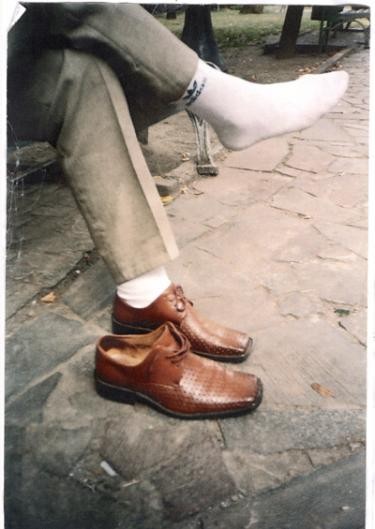Paulien Oltheten
20 Oct - 24 Nov 2007
PAULIEN OLTHETEN
"Theorie van de straat"
Art used to be seen as an elevated form of knowledge. In the paragone, Leonardo Da Vinci describes the fine arts – painting, in his case – as the highest form of art. In pursuit of these heights, Leonardo carried out all sorts of experiments that would today be assigned to the realm of science. The greatness of a work of art was believed to be linked in a sense to the knowledge it encompassed. In our own times, the concept of knowledge tends to be linked to exact, scientific facts; it has not been associated with art, in the popular mind, for a very long time.
Paulien Oltheten draws on this tradition in a variety of experiments to gain more insight into the world around her, on the path towards creating Art. But her research does not revolve around abstractions or formulae; she studies ‘the theory of the street’.
At a chaotic square in New York City, Paulien Oltheten found a man sitting quietly observing the tumult around him. With his broad back and light-coloured shirt catching the sunlight, in a pose conveying serenity of mind, the man contrasts sharply with his surroundings. Oltheten photographed this scene. But what is the significance of this image? What kind of ‘knowledge’ is contained in this man’s pose?
What kind of knowledge or understanding is conveyed by the little old woman who shuffles through a village at an excruciatingly slow pace? Oltheten’s remarkable ‘finds’ in everyday images are subordinated to a process of simulation: of the stance or pose, the pace of movement, the lines of a scene. Oltheten engineers this simulation by putting herself almost literally in the old woman’s shoes, for instance, by shuffling through the village like her for an hour. These projects do not involve the scientific calculation of phenomena, but are rather exercises in recording life’s impressions as someone else. Like a sort of anthropologist, Oltheten seeks to discover the knowledge concealed within the other.
In her research into ‘the theory of the street’, Paulien Oltheten’s keen eye for this kind of knowledge plays an important role. Her photographs, videos and notes provide a subtle picture of what normally remains unseen, things that most of us take for granted. Without judging, without attaching sentimental connotations to a scene, she lays bare the most intimate of moments. She combines photographs of observations in her installations or collages with brief notes, drawings of experiments, and videos of herself and others. In her research, she constantly creates new combinations of old and new images, giving rise to fresh insights into what the street can teach us.
"Theorie van de straat"
Art used to be seen as an elevated form of knowledge. In the paragone, Leonardo Da Vinci describes the fine arts – painting, in his case – as the highest form of art. In pursuit of these heights, Leonardo carried out all sorts of experiments that would today be assigned to the realm of science. The greatness of a work of art was believed to be linked in a sense to the knowledge it encompassed. In our own times, the concept of knowledge tends to be linked to exact, scientific facts; it has not been associated with art, in the popular mind, for a very long time.
Paulien Oltheten draws on this tradition in a variety of experiments to gain more insight into the world around her, on the path towards creating Art. But her research does not revolve around abstractions or formulae; she studies ‘the theory of the street’.
At a chaotic square in New York City, Paulien Oltheten found a man sitting quietly observing the tumult around him. With his broad back and light-coloured shirt catching the sunlight, in a pose conveying serenity of mind, the man contrasts sharply with his surroundings. Oltheten photographed this scene. But what is the significance of this image? What kind of ‘knowledge’ is contained in this man’s pose?
What kind of knowledge or understanding is conveyed by the little old woman who shuffles through a village at an excruciatingly slow pace? Oltheten’s remarkable ‘finds’ in everyday images are subordinated to a process of simulation: of the stance or pose, the pace of movement, the lines of a scene. Oltheten engineers this simulation by putting herself almost literally in the old woman’s shoes, for instance, by shuffling through the village like her for an hour. These projects do not involve the scientific calculation of phenomena, but are rather exercises in recording life’s impressions as someone else. Like a sort of anthropologist, Oltheten seeks to discover the knowledge concealed within the other.
In her research into ‘the theory of the street’, Paulien Oltheten’s keen eye for this kind of knowledge plays an important role. Her photographs, videos and notes provide a subtle picture of what normally remains unseen, things that most of us take for granted. Without judging, without attaching sentimental connotations to a scene, she lays bare the most intimate of moments. She combines photographs of observations in her installations or collages with brief notes, drawings of experiments, and videos of herself and others. In her research, she constantly creates new combinations of old and new images, giving rise to fresh insights into what the street can teach us.

